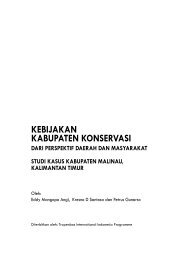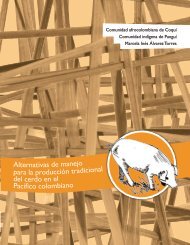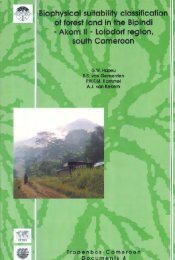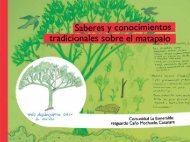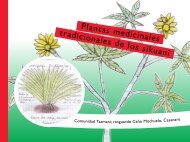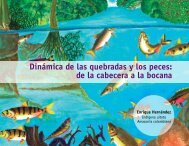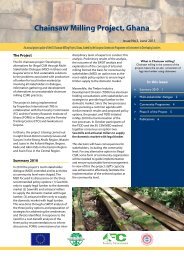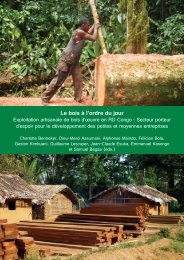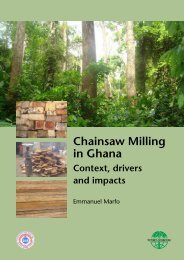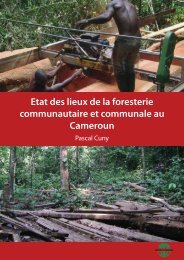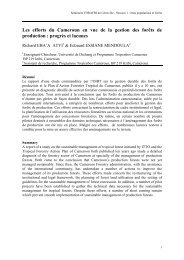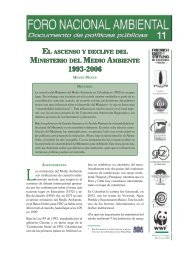Download the publication - Tropenbos International
Download the publication - Tropenbos International
Download the publication - Tropenbos International
You also want an ePaper? Increase the reach of your titles
YUMPU automatically turns print PDFs into web optimized ePapers that Google loves.
General conclusions and implications for biodiversity conservation<br />
compatible with conservation initiatives and include a separate management strategy<br />
aimed at enhancing <strong>the</strong> sustainable management of natural resources. Taking into<br />
consideration <strong>the</strong> fact that <strong>the</strong> success of <strong>the</strong>ir conservation will largely depend on<br />
<strong>the</strong> ability to reconcile <strong>the</strong> objectives of conservation and toge<strong>the</strong>r with <strong>the</strong> needs of<br />
<strong>the</strong> loggers and <strong>the</strong> local communities, <strong>the</strong> management strategy should be<br />
developed with <strong>the</strong> full participation of <strong>the</strong> local people.<br />
The Ma’an area has been recently allocated for timber exploitation (FMU 09024). It<br />
supports small populations of Okoumé at <strong>the</strong> border with Equatorial Guinea with<br />
only few stems of exploitable size. This important commercial timber species is of<br />
scientific interest since it reaches <strong>the</strong> nor<strong>the</strong>rn limit of its distribution in <strong>the</strong> Campo-<br />
Ma’an area. Therefore, it is strongly recommended that Okoumé should not be<br />
exploited and that conservation measures be taken during logging to ensure <strong>the</strong><br />
protection of this species. Fur<strong>the</strong>rmore, special logging techniques should be applied<br />
in order to minimise logging damage such as breakage of Okoumé trees, saplings<br />
and residual stems, and to protect eventual seedlings from discarded crowns of<br />
felled trees.<br />
Although selective logging techniques are used in <strong>the</strong> FMU, a number of<br />
irregularities were reported in <strong>the</strong> area, as far as <strong>the</strong> proper application of <strong>the</strong><br />
techniques and <strong>the</strong> implementation of <strong>the</strong> forestry law that regulates logging<br />
activities in Cameroon are concerned. It is suggested that selective logging at low<br />
intensity, using techniques that minimizes impacts, be applied in all FMU.<br />
Fur<strong>the</strong>rmore, research should be carried out to assess <strong>the</strong> current logging techniques<br />
and <strong>the</strong> level of implementation of <strong>the</strong> forestry law. The results of this research<br />
should include recommendations for a sustainable timber harvesting, <strong>the</strong> use of<br />
adequate selective logging techniques, and control mechanisms to minimise<br />
bottlenecks that hinder <strong>the</strong> proper implementation of <strong>the</strong> forestry law. It was also<br />
noticed that <strong>the</strong> amount of waste products derived from logging and timber<br />
transformation activities was high. The waste products include abandoned logs and<br />
remains from sawmills. Although <strong>the</strong>y were reported not to be economically<br />
profitable by <strong>the</strong> loggers, <strong>the</strong>se abandoned logs are of great economic importance for<br />
<strong>the</strong> rural and urban economy. Therefore, fur<strong>the</strong>r studies should be carried out to<br />
assess <strong>the</strong> demand, markets and trade of <strong>the</strong>se products, and to identify an effective<br />
mechanism that will help to minimise this waste.<br />
The Campo-Ma’an area has ca 249 NTFPs and 112 timber species of which only 60<br />
species are being exploited (Tchouto et al., 2002 unpublished). Although <strong>the</strong> TOU<br />
has many NTFP species with high economic value, few local people rely on it as<br />
source of income. Fur<strong>the</strong>rmore, many important forest products such as fruits,<br />
spices, vegetables and rattans that are popularly traded in Cameroon and <strong>the</strong> subregion<br />
for <strong>the</strong>ir high commercial values, are poorly exploited in <strong>the</strong> area. This is<br />
partly due to <strong>the</strong> fact that many local people derive <strong>the</strong>ir income from agriculture,<br />
hunting and fishing, and that <strong>the</strong> commercialisation channels of <strong>the</strong>se products are<br />
poorly known by <strong>the</strong> local communities. In order to reduce <strong>the</strong> current pressure on<br />
<strong>the</strong> Campo-Ma’an rain forest, alternate income generating activities should be<br />
identified for <strong>the</strong> local communities. The trade of NTFPs is one of such activities if<br />
an adequate strategy for its sustainable management, exploitation and<br />
commercialisation is developed. Therefore, a participatory ethnobotanical study<br />
121



